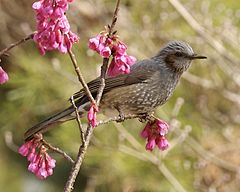- Brown-eared Bulbul
-
Brown-eared Bulbul 
Adult, subspecies squamiceps, Kyoto (Japan) Conservation status Scientific classification Kingdom: Animalia Phylum: Chordata Class: Aves Order: Passeriformes Family: Pycnonotidae Genus: Microscelis
G.R.Gray, 1840Species: M. amaurotis Binomial name Microscelis amaurotis
(Temminck, 1830)Synonyms [1]
Genus:
Galgulus Kittlitz, 1832 (non Brisson, 1760: preoccupied)
Orpheus Temminck & Schlegel, 1848 (non Swainson, 1827: preoccupied)
Species:
Hypsipetes amaurotis (Temminck, 1830)
Ixos amaurotis (Temminck, 1830)
Turdus amaurotis Temminck, 1830The Brown-eared Bulbul (Microscelis amaurotis) is a medium-sized bulbul which is found from the Russian Far East (including Sakhalin), northeastern China, the Korean Peninsula, and Japan, south to Taiwan and the Babuyan and Batanes island chains in the north of the Philippines, occasionally being found in Luzon. It is extremely common within the northern parts of its range, and is a familiar bird throughout Japan, where it is called hiyodori (ヒヨドリ), and Korea, where it is known as chinpan (직박). In Taiwan on the other hand it is rare and limited to Orchid Island [1].
Reaching a length of about 28 cm, Brown-eared Bulbuls are grayish-brown, with brown cheeks (the "brown ears" of the common name) and a long tail. While they prefer forested areas, they readily adapt to urban and rural environments, and their noisy squeaking calls are a familiar sound in most areas of Japan.
This species was long placed in the genus Hypsipetes, at that time an indiscriminate assemblage of more or less related bulbul species. Later, its distinctness was recognized and it was variously placed in the genus Ixos or given a genus of its own, Microscelis. Analysis of mtDNA NADH dehydrogenase subunits 2 and 3 and nDNA β-fibrinogen intron 7 sequence data suggests that the treatment as monotypic genus is most appropriate, at least as long as Hypsipetes is not merged into Ixos.[2]
Historically, Brown-eared Bulbuls are migratory birds moving to the southern parts of its range in winter, but they have taken advantage of changes in crops and farming practices in recent decades to overwinter in areas farther north than previously possible. As a result, they are considered agricultural pests in some areas of Japan. Most Brown-eared Bulbuls still move south in winter, often forming huge flocks during migration. In summer, Brown-eared Bulbuls primarily feed on insects, while they primarily take fruits and seeds in the fall and winter.
Footnotes
References
- BirdLife International (BLI) (2008). Ixos amaurotis. In: IUCN 2008. IUCN Red List of Threatened Species. Downloaded on 7 June 2009.
- Gray, G.R. (1840): A list of the genera of birds with an indication of the typical species of each genus compiled from various sources (1st edition): 28. London. Available at Gallica (search for "Gray")
- Gregory, Steven M. (2000): Nomenclature of the Hypsipetes Bulbuls (Pycnonotidae). Forktail 16: 164-166. PDF fulltext
- Moyle, Robert G. & Marks, Ben D. (2006): Phylogenetic relationships of the bulbuls (Aves: Pycnonotidae) based on mitochondrial and nuclear DNA sequence data. Mol. Phylogenet. Evol. 40(3): 687-695. doi:10.1016/j.ympev.2006.04.015 (HTML abstract)
External links
 Media related to Microscelis amaurotis at Wikimedia Commons
Media related to Microscelis amaurotis at Wikimedia Commons- Brown-eared Bulbul at Avibase
- Damage to Crops by Birds study at Okinawa University
Categories:- IUCN Red List least concern species
- Pycnonotidae
- Birds of Asia
Wikimedia Foundation. 2010.

